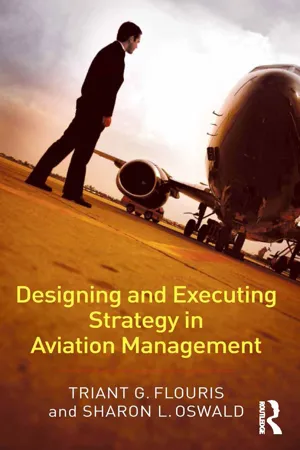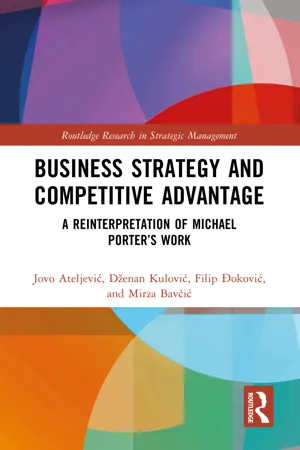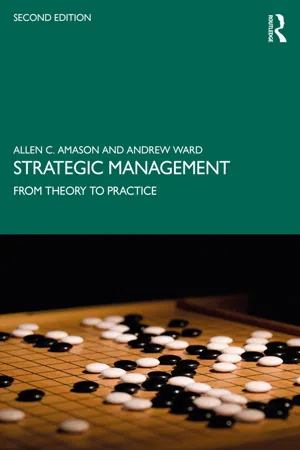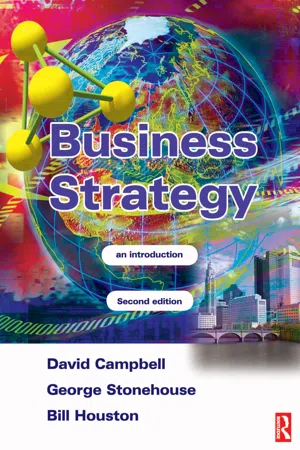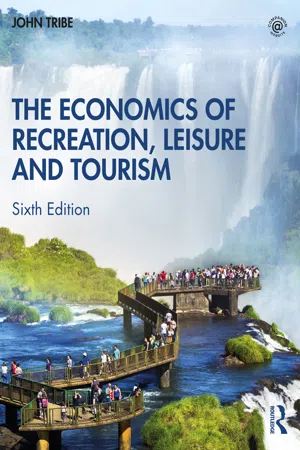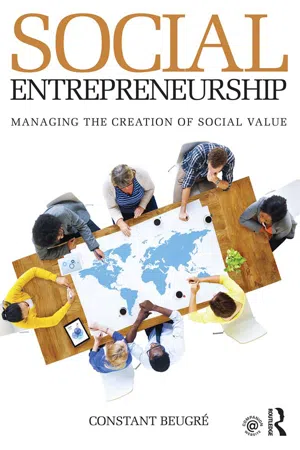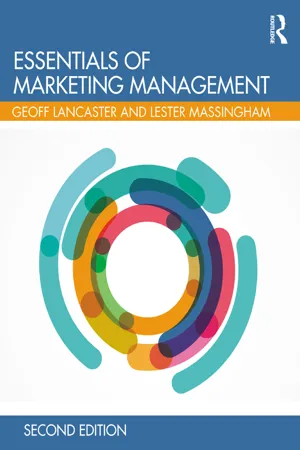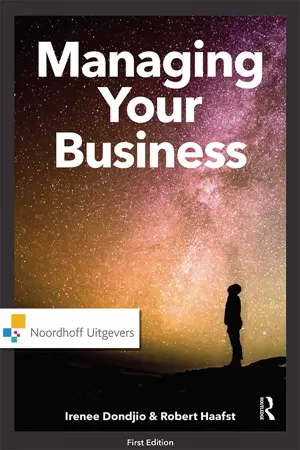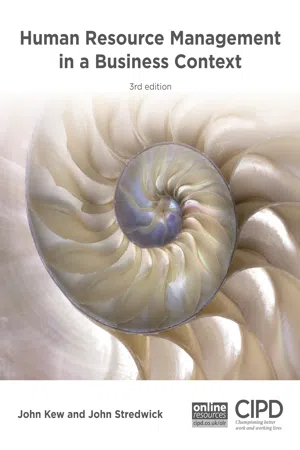Business
Competitive Environment
The competitive environment refers to the dynamic landscape in which businesses operate, characterized by the presence of rival companies vying for market share, customers, and resources. It encompasses factors such as industry competition, market saturation, and the impact of new entrants and substitutes. Understanding and adapting to the competitive environment is crucial for businesses to thrive and maintain a competitive edge.
Written by Perlego with AI-assistance
Related key terms
Related key terms
1 of 4
Related key terms
1 of 3
10 Key excerpts on "Competitive Environment"
- Triant G. Flouris, Sharon L. Oswald(Authors)
- 2016(Publication Date)
- Routledge(Publisher)
Some of the characteristics that affect the competitive playing field include the size and growth rate of the market, the depth and breadth of products in the market, the uniqueness of these products (or likeness as in commodity products), the existence or availability of distribution channels, the dependence and sensitivity toward technological changes, the make-up of the buyer and seller market and the effect of new entrants and economies of scale to the long-term success in the market. No two industries are identical and no two industries face identical competitive pressures. Some industries, like the airline industry, were introduced for the first time to the often cutthroat behavior of a Competitive Environment after many years of regulated complacency. Understanding the competitive pressures and how to exist within these conditions is paramount to industry survival.Before moving forward in this discussion of analyzing the Competitive Environment, it is important to discuss the pressures that affect competition. Without a thorough understanding of these pressures and how they affect the businesses of an industry, it is nearly impossible to craft a sustainable competitive strategy.Michael Porter’s Five Competitive Forces
In 1980, Michael Porter published a framework for analyzing the competitive pressures in all industries.8 While industries differ greatly in their composition, Porter argued that all industries face similar competitive forces. Porter’s model of the Five Forces of Competition is presented in Figure 4.3 .Figure 4.3 Porter’s Five Forces of CompetitionPorter’s model provides a very simple yet methodical way to dissect an industry and determine the true pressures that affect the marketplace. The Five Forces model suggests that the competition in an industry is determined by five competitive forces:1. Barriers to Entry. 2. The Power of the Supplier Market. 3. The Power of the Buyer Market. 4. Power of Substitute Products. 5. Rivalry among Industry Members.Barriers to Entry
A barrier to entry into an industry occurs when it is difficult for a newcomer to enter into the market. New entrants in a market can change the complexion of the industry and almost always provide a challenge to the existing firms due to the newcomer’s ability to carve out a portion of the market. However, sometimes it is difficult for a newcomer to gain a foothold in an existing market. There are many types of barriers that could provide a challenge to newcomers entering in a given market. Some of these are as follows.Economies of scale- eBook - ePub
Business Strategy and Competitive Advantage
A Reinterpretation of Michael Porter's Work
- Jovo Ateljević, Dženan Kulović, Filip Đoković, Mirza Bavčić(Authors)
- 2023(Publication Date)
- Routledge(Publisher)
All the stated resource classifications (explained comprehensively and in detail) reinforce the hypothesis that there is a vast number of potential resources as well as the importance of their successful utilisation. A reaction is therefore needed based on the collected information on an industry.When reacting to gathered information on an industry, it is necessary to understand, interpret and correlate the information to reach relevant conclusions on the value of available information. The information concerning the given industry is important since the industry has a direct impact on the company (Mašić, 2009 ).According to Michael Porter (1983) , the relative environment is considerably broad and it includes the respective social and economic factors and it is a key aspect of the environment of the industries (or an industry) which is the competing field of the organisation.An analysis of the definition reveals that, in modern conditions, an industry does not have demarking lines. This means that each company can be both a rival and a competitor, simultaneously.However, the partner relationship can be easily transformed into a competitive relationship. For example, if a buyer starts producing items which it formerly bought or if a supplier starts using products for his own business, rather than for sales. If we add potential competitors and the possibility of substitution to this scenario, it can be concluded that the competitive outreach, i.e. the range of contact with competitors, is much wider than the range indicated by the industry analysis.However, the definition offered by Michael Porter is not accepted by contemporary theoreticians and practicians. Hence, he approached it from a broader aspect and expanded the competitive context beyond the industry (i.e. the competition among existing companies) to include suppliers, buyers, new competitors and substitute producers. He called it extended rivalry and he used it to set the boundaries of an industry. Considering his analysis of these five variables, there can be a so-called good and bad environment (Table 4.1 ; Bateman and Zeithaml, 1990 - eBook - ePub
- Helgi Thor Ingason, Haukur Ingi Jonasson(Authors)
- 2018(Publication Date)
- Routledge(Publisher)
5 Understanding the business landscape: the supply chain, competitors, and regulatorsEvery enterprise operates in the context of a dynamic external environment. The operating environment of a business includes social, technological, and market forces as well as organisations that will influence the strategies of an enterprise in a variety of important ways that can be hard to predict. Among the principal initial tasks when you are planning any strategy is the characterisation of this external environment, surfacing the forces at work and identifying the extent to which particular elements are risks or opportunities that may influence the fortunes of an enterprise. This is a key part of defining the current status of an enterprise. In any strategic plan, recognising and dealing with the most influential aspects first is likely to be the effective course of action, although this may be easier said than done.There is no set formula that can be applied to identify all the sources of influence in the external environment. The best approach is perhaps to hold some form of a brainstorming session with a diverse array of informed people (including external consultants, if necessary) in order to construct as comprehensive a picture of the external environment, together with associated risks and opportunities, as you can. Whether an enterprise is commercial or non-profit, the nature of its operations can have a major bearing on what aspects are important in the external environment and the kind of thinking required to ensure future success. Natural monopolies such as municipal authorities will have a different viewpoint from, say, a small enterprise operating on tight margins in a highly competitive market. Equally, the viewpoint of a small volunteer organisation with a fragile funding pipeline that is meeting an important social need will differ hugely from that of a Fortune 500 company. - eBook - ePub
Strategic Management
From Theory to Practice
- Allen Amason, Andrew Ward(Authors)
- 2020(Publication Date)
- Routledge(Publisher)
Chapter 4 Analyzing the EnvironmentDefining the Business and the Environment The Macro-Environment: PESTEL Framework Analyzing the Competitive Environment The 5-Forces Model Bargaining Power of the Seller Bargaining Power of the Buyer Availability of Substitutes Threat of New Entrants Rivalry Among Competitors Competitiveness and the Lifecycle Model Ongoing Evolution in the Environment Concluding Thoughts and Caveats Hypercompetition Industry Definition Locus of CompetitionHaving detailed in the previous chapter the various “tools” of the strategic manager’s trade, this chapter looks in detail at one of those tools, the analysis of the environment. In terms of immediacy, the environment is probably the most important component of strategic success. This is because, as many contend, the environment “determines” the success of a company’s strategy. This view or belief reflects a deterministic view of strategy (Bourgeois, 1984; Child, 1972).The academic debate between determinism, the view that strategic success is a function of analytical precision and fixed cause and effect relationships, and voluntarism, the view that strategic success is a function of creativity, innovation, and the exercise of strategic choice, is not a matter of great practical importance. However, the tension between these two philosophies does reflect a comparable and essential tension between two practical strategic philosophies, proaction and reaction.A cursory browsing of the day’s popular business books will reveal any number of titles dealing with proaction, leadership, taking the initiative, and seizing the moment. However, a relative few are likely to spend much time on the importance of reaction. Indeed, the subject of reaction is far less popular and so often largely ignored. Undoubtedly, there is something satisfying about being first. Especially in business, we tend to celebrate leaders rather than followers. However, the reality is that leading is an imprecise science that often entails significant risk. Sometimes it is better to wait, to allow others to do the basic work of research and development and then to simply react quickly to the emerging changes in the marketplace. Thus, well-timed and appropriate reaction is an important part of strategy. Indeed, in some instances, reaction may be the very key to survival. At the same time, there are instances where being first can yield clear and sustainable advantages. In these cases, a firm would do well to accept the risks and step out ahead of the competition and, sometimes, ahead of the accepted wisdom. - eBook - ePub
- George Stonehouse, Bill Houston(Authors)
- 2003(Publication Date)
- Routledge(Publisher)
The micro (or near) environment is that which immediately surrounds a business, the parts of which the business interacts with frequently and over which it may have some influence. For most purposes, we can identify competitors, suppliers and customers as comprising the main constituents of this strata of the environment.- The macro (or far) environment comprises those influences that can affect the whole industry in which a business operates. The macroenvironment comprises influences arising from socio-demographic, political, economic, natural and technological factors. The nature of these factors normally means that individual businesses are unable to influence them – strategies must usually be formulated to cope with changes in the macroenvironment.
Porter's five forces model of industry analysis
Porter (1980) developed a framework for analysing the nature and extent of competition within an industry. He argued that there are five competitive forces which determine the nature of competition within an industry. Understanding the nature and strength of each of the five forces within an industry assists managers in developing the competitive strategy of their organization. The five forces are:- the threat of new entrants to the industry;
- the threat of substitute products;
- the power of buyers or customers;
- the power of suppliers (to businesses in the industry);
- rivalry among businesses in the industry.
By determining the relative ‘power’ of each of these forces, an organization can identify how to position itself to take advantage of opportunities and overcome or circumvent threats. The strategy of an organization may then be designed to exploit the competitive forces at work within an industry.When using Porter's framework (see Figure 7.1 - eBook - ePub
- John Tribe(Author)
- 2020(Publication Date)
- Routledge(Publisher)
Chapter 9 .By studying this chapter, students will be able to describe and analyse an organization’s:Figure 8.1 Strategic drift- Competitive Environment
- technological environment
- political environment
- sociocultural environment.
The Competitive Environment
In his book Competitive Strategy, Porter (1980) proposed the model shown in Figure 8.2 (the Five Forces) for investigating the Competitive Environment:- the threat of entrants
- the power of suppliers
- the power of buyers
- the threat of substitutes
- competitive rivalry.
The threat of entrants
The threat of new entrants into an industry will have a significant effect on a recreation, leisure or tourism organization. New entrants may stimulate more price competition or more investment in product differentiation as they attempt to win market share and profits and existing firms seek to defend market share and profits. Chapter 6 - eBook - ePub
Social Entrepreneurship
Managing the Creation of Social Value
- Constant Beugré(Author)
- 2016(Publication Date)
- Routledge(Publisher)
Environmental scanning can help a firm identify the driving forces in the industry in which it operates. Driving forces represent major causes of changing industry and competitive conditions. For a company to formulate its strategic plan, it needs to identify the driving forces in the industry in which it operates. Generally, three to four driving forces must be identified and their impact on the industry over a period of one to three years must be assessed. Examples of driving forces include: increasing globalization, internet opportunities, regulatory policies/government legislation, changing societal concerns, attitudes, and lifestyles, and changes in the degree of uncertainty and risk. Then the firm must assess the impact of these driving forces on the industry in which it operates.An interesting question is whether this strategic management tool could be applied to social entrepreneurship. Because the purpose of social ventures is not to generate profits for stakeholders but rather to address social issues, applying a competitive tool might sound odd. However, at close examination, one may find it useful to apply this tool to social ventures. It is important for social entrepreneurs to understand the landscape in which their ventures will operate. For instance, will a social venture in a particular area, such as healthcare, succeed? What are the driving forces in this particular area? What are the critical success factors? Addressing these questions is important for social entrepreneurs, especially when the social venture combines a social mission with a profit-generating bottom line.3.2 Competitive Intelligence
Competitive intelligence is a strategic management tool that is used to garner useful information about the competition, the market, and the technology that can be utilized by managers to make strategic decisions.69 - eBook - ePub
- Geoffrey Lancaster, Lester Massingham(Authors)
- 2017(Publication Date)
- Routledge(Publisher)
The goal of competitive strategy is to find a position in the industry where the company can best defend itself against these forces, or can influence them in its favour. Knowledge of these underlying pressures highlights critical strengths and weaknesses of the company, shows the position in the industry, clarifies areas where strategy changes yield the greatest pay-off and highlights areas where industry trends hold greatest significance as opportunities or threats. Structure analysis is fundamental for formulating competitive strategy.The five competitive forces in Porter’s model
As suggested earlier, the five competitive forces suggested by Porter jointly determine the intensity of industry competition and hence profitability. As Figure 14.6 shows, each of the five major forces in turn comprises a number of elements which together combine to determine the strength of each factor and hence its effect on competitiveness. Some of these are outlined here.New entrants can potentially serve to increase the degree of competition in an industry. In turn, the threat of new entrants is largely a function of the extent to which barriers to entry exist in the market. Some of the key factors affecting these entry barriers include:• economies of scale;• product differentiation and brand identity;• capital requirements;• switching costs;• government policy;• access to distribution.Because high barriers to entry can make even a potentially lucrative market unattractive (or even impossible) to enter for new competitors, the marketing planner should not take a passive approach but should actively pursue ways of raising barriers to new competitors.The Porter model of competitive industry structureFigure 14.6The bargaining power of suppliers is greater when, for example:• supply is dominated by a few companies and they are more concentrated than the industry they sell to;• their products are unique or differentiated, or if they have built up switching costs;• they are not obliged to contend with other products for sale to the industry;• they pose a credible threat of integrating forward into the industry’s business;• the industry is not an important customer to the supplier group.The bargaining power of buyers is greater when, for example:• they are concentrated or purchase in large volumes;• - eBook - ePub
Managing Your Business
A Practical Guide
- Irenee Dondjio, Robert Haafst(Authors)
- 2019(Publication Date)
- Routledge(Publisher)
Part 2 The External Business Environment Part 2 takes a closer look at the company environment: both the market and the industry a company operates in. Establishing the relevant industry and its characteristics is essential for any company. Yet, surprisingly, this aspect is not always clearly defined. For instance, would the tesla company be best described as a car maker, a tech company (like apple), or a service company that provides a mean of transport? This is important knowledge for a company to have, because it wants to be aware of potential competitors and potential alternatives for customers. Logically, the same applies to markets. Once the relevant market has been established, a company needs to know which competitors to expect, and how consumers in this market behave. Again, the relevant market is not always crystal clear; potentially not even to the company itself. But it is important to understand that the choice of market can make a real difference. Shell comes to mind. If their mission is limited to selling oil, they might just go out of business in about 50 years due to market developments. Part 2 aims to answer industry and market related questions and to provide a number of tools that will help in analysing the market and the industry a company operates in. Additionally, it promotes a critical discussion of potential new markets for existing companies - eBook - ePub
- John Kew, John Stredwick(Authors)
- 2016(Publication Date)
- CIPD - Kogan Page(Publisher)
The economic theory of market structure, distinguishing perfect and monopolistic competition, monopoly and oligopoly, provides a powerful but inevitably simplified model. The real industrial world is much more complex. One important model which attempts to match this complexity is Michael Porter’s Five Forces model of competitive rivalry (Porter 1980).According to the model, the structure of competition in an industry can be described in terms of five major forces. These are:- the threat of entry of new firms
- the power of buyers
- the power of suppliers
- the power of substitutes
- the intensity of rivalry among existing forms.
Each of the five forces is itself determined by a number of different factors. When the five forces are completely analysed, this determines how attractive the industry is to firms within it, and those who might wish to enter it.Unlike economic models, the value of this model lies not in its predictive ability, but in the way in which it provides a checklist whereby particular firms can clearly analyse and define their own position in relation to their own industry. It is a tool which can be used as the first stage of strategic analysis.The threat of entry
The threat of entry of new firms to an industry depends on the extent of barriers to entry. These include:- Economies of scaleSome industries have very high economies of scale – unit costs of output fall considerably as output increases, as in the car industry or the aircraft industry. Others have very low economies of scale, for example estate agency. A new firm seeking to enter an industry with big economies of scale must either buy a high market share on entry or suffer a cost disadvantage. Economies of scale are measured by the concept of Minimum Efficient Scale (MES), or the market share which is necessary to compete at minimum unit cost. It is also possible to calculate the cost penalty incurred by producing at below this volume. However, note first that globalisation has meant increasingly that what is significant is not share of the UK market, but share of a world market, and secondly, that lean production and flexible manufacturing techniques like Just in Time have somewhat reduced the importance of economies of scale.
Index pages curate the most relevant extracts from our library of academic textbooks. They’ve been created using an in-house natural language model (NLM), each adding context and meaning to key research topics.
Explore more topic indexes
Explore more topic indexes
1 of 6
Explore more topic indexes
1 of 4
